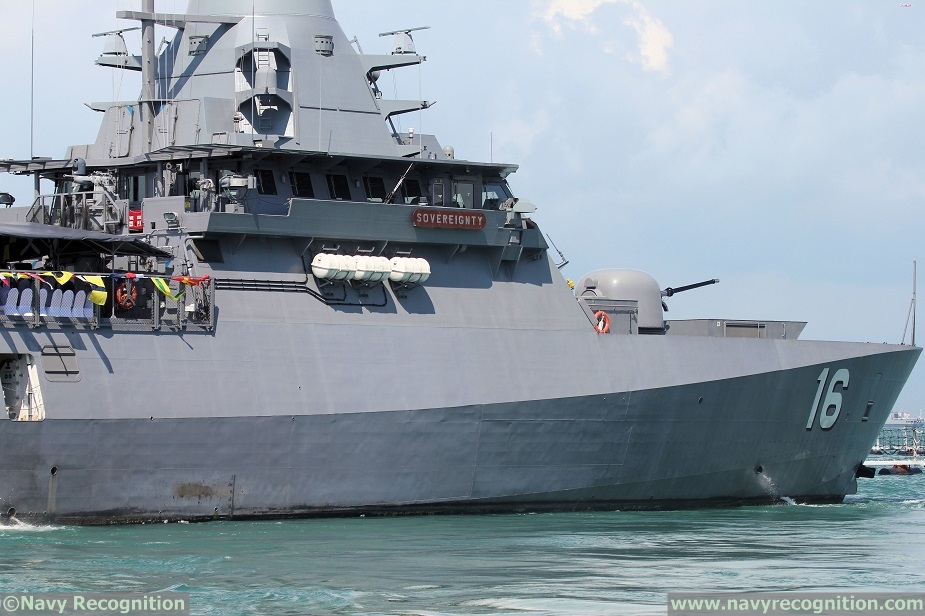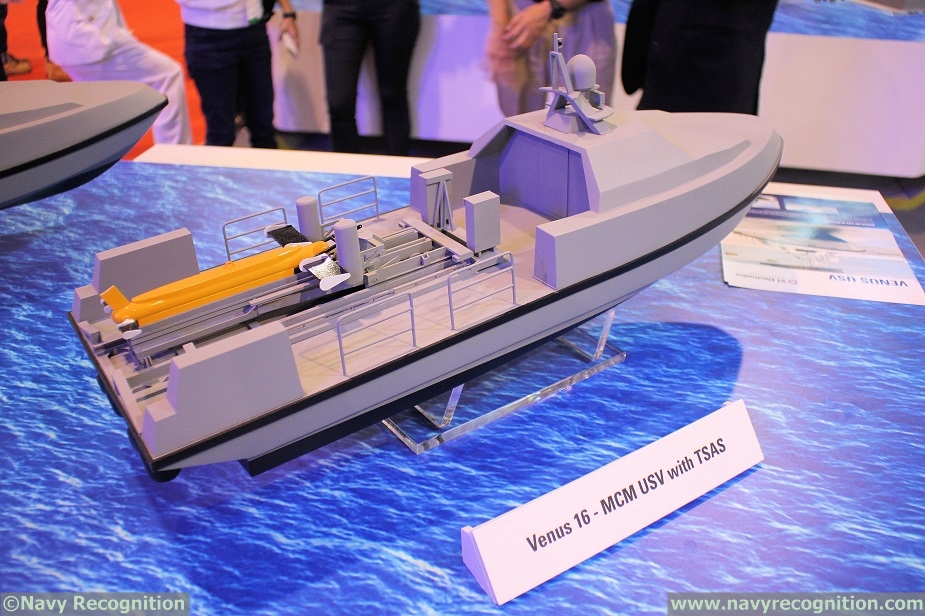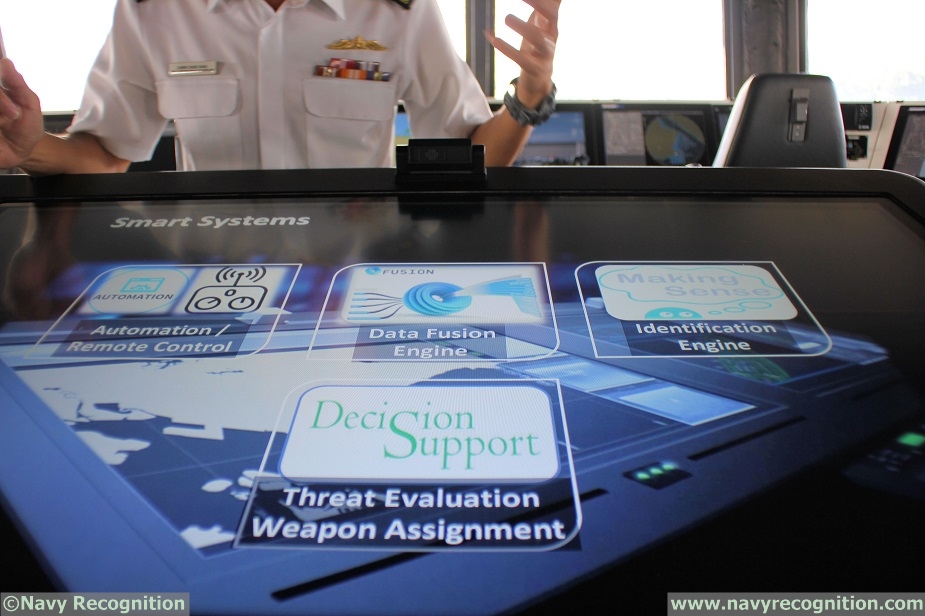The Republic of Singapore Navy (RSN) unveiled last week its "Smart Defence Initiatives" as it tries to harness the latest technological developments, such as robotics, artificial intelligence and data analytics, to enhance its capabilities and operational effectiveness.

According to the RSN, the security environment is becoming more complex and uncertain, and we now face a wider spectrum of threats. This is particularly true for Singapore, a maritime nation situated amongst many small islands, and having to deal with a porous maritime security environment. In addition, as a maritime trade hub, the waters that the Republic of Singapore Navy (RSN) protects are extremely congested with both large merchant vessels and small craft transiting through the narrow Singapore Strait.
Our video coverage aboard RSS Independence, the first LMV
Revolutionary Ship Design -- Littoral Mission Vessel (LMV)
The RSN's newest class of ships, developed in partnership with the Defence Science and Technology Agency (DSTA) and Singapore Technologies Marine, features many innovative design concepts for both operations and engineering support. The design process adopted a novel "design the support" approach, where key downstream engineering and logistics support considerations were factored upfront in the vessel's design. Its stacked mast maximises sensor coverage while allowing maintenance to be carried out more efficiently, and has led to the reduction of time spent at dock for mast-related defects. In addition, the LMVs are designed to be more capable than the Patrol Vessels (PVs) they replaced. Key features include (i) the co-location of the Bridge, Combat Information Centre and Machinery Control Room in the Integrated Command Centre for more effective and efficient maritime security operations; and (ii) automation, sense-making and decision support systems for both combat and platform systems. This has enabled the multi-mission capable LMVs to be operated with a leaner baseline crew of 23 personnel, as compared to the 30-man PVs, even though the LMVs are larger and more complex vessels. The innovative design solutions to our LMVs will save us at least $65 million across the 30-year life span of the platform, when compared to the PVs.

Unmanned Vessels to Enhance Maritime Security and Homeland Defence.
Currently, the RSN operates manned ships to patrol the Singapore Strait and scan the seabed for mines to keep our shipping lanes safe for navigation. The RSN is developing three types of Unmanned Surface Vessels (USVs), namely the Coastal Defence USV to conduct coastal patrols, the Mine Countermeasure USV with Towed Synthetic Aperture Sonar (TSAS) to conduct underwater scans of the seabed to detect mines, and the Mine Countermeasure USV with Expendable Mine Disposal System to conduct mine disposals (refer to Table 1 below for more details on their technical specifications). DSTA worked closely with the RSN to achieve semi-autonomous operation of the TSAS, through an automatic Launch and Recovery System that allows the operator to remotely launch the sonar as well as recover the sonar upon completion of survey operations. In addition, the fully automated detection and classification system on board the USV is able to rapidly detect and classify mines, reducing the time required by more than 50%.
Video interview on ST Marine's USV projects at IMDEX 2017
Equipped with advanced sensors and software, all three types of USVs will provide comprehensive maritime security for Singapore. When operational, the USVs can perform their tasks at much lower cost and with less manpower than manned platforms. The Coastal Defence USVs will eventually take over the role of patrols in the Singapore Strait, which is currently undertaken by the PVs and LMVs. This will allow our manned warships, like the LMVs, to be deployed at further ranges from Singapore, and more strategically for complex missions. As overall programme manager for the USVs, DSTA ensures that the USVs meet design objectives through rigorous technical assessments and feasibility studies. The key features of the USVs include:
a. High Speed and Better Manoeuvrability. The USVs are designed for high speed and manoeuvrability for its operations. The USV’s hull also enables good sea-keeping, allowing the USVs to operate in the Singapore Strait even during monsoon seasons.
b. Autonomous Navigation with Collision Avoidance. The USVs can navigate safely and operate autonomously in proximity with other vessels with the in-built Collision Detection and Collision Avoidance system. The USVs are also able to manoeuvre autonomously by waypoint navigation and maintain its position relative to other vessels. This reduces the workload and frees up the capacity of the operator remotely controlling the USV in the Singapore Strait, which is the busiest shipping lane in the world, to have increased situational awareness and ability to detect suspicious activity.
c. Low Manning. With the high level of autonomy and integrated Command and Control systems aboard, the Operator Control Station located ashore or on board platforms at sea, can control the movement and payload of the USV with minimal manpower required.

Enhancing Operational Effectiveness
Leveraging Data Analytics for Predictive Maintenance. Equipment maintenance on board the ship is currently conducted according to pre-planned schedules. Defects are rectified as and when they occur, which impacts readiness and increases costs. The RSN is conducting trials to use data analytics on key equipment parameters such as engine health, vibration and temperature data on critical systems to predict when defects may occur. Ship crew will then be triggered to take pre-emptive steps to prevent defects and avoid costly repairs. Currently, trials for predictive maintenance of the frigate's diesel generators are being conducted and the resultant cost savings are projected to be $1 million per year, with the potential to adapt it for other systems.
Smart Base Access. Currently, the base security screening process is labour-intensive and time-consuming. The RSN has started a Smart Base Access project that utilises a combination of facial recognition and digital identification to simplify the process while maintaining high security standards. Without the need for laborious verification methods, the Smart Base Access project will reduce the number of security personnel required and could generate savings of $160,000 per year in Changi Naval Base alone. The trial for Smart Base Access will start at the end of February 2018.
Enhancing Maritime Security
Leveraging Data Analytics to Enhance Maritime Security. As the national lead for the Whole-of-Government (WoG) Maritime Security (MARSEC) efforts, the RSN is continually refining the system and leveraging data analytics improve detection of anomalies and its sense-making capabilities.
a. Improving Anomaly Detection with Video Analytics. The RSN has a comprehensive network of coastal surveillance sensors to detect any maritime threats in the Singapore Strait. The RSN is collaborating with DSTA and DSO National Laboratories to develop video analytics to automatically classify vessels and flag out anomalies, in order to increase situational awareness and reduce human error. This will increase the RSN’s operational efficiency and translate to manpower savings of about 30%, as personnel who were previously conducting manual scanning of video screens can now focus on higher-end tasks.
b. Improving Sense-making Capabilities. The RSN-led Singapore Maritime Crisis Centre (SMCC) is developing a sense-making system that collates and fuses information from Whole-of-Government agencies and open sources, and applies data analytics to uncover MARSEC threats and activate operational responses to deal with possible terrorist plots. For example, the National Maritime Sense-Making Group (NMSG) within the SMCC analyses data from a vessel's voyage and its crew's "pattern of life" to assess potential threats. This information has been used to cue other national agencies to check suspicious vessels and even deny specific crew members from entering Singapore. NSMG has also worked with the Police Coast Guard (PCG) to analyse parameters of previous smuggling incidents to obtain the vessel types that has a higher probability of being involved in smuggling activities. This has allowed the PCG to be more targeted in the vessels they inspect.

Q&A with Collin Koh, South East Asia Maritime Security expert
Navy Recognition (NR) - In your opinion, does the LMV really brings a plus to the RSN or was the program launched to benefit the local industry (ST Marine) first and foremost ?
Collin Koh (CK): It really brings a plus to the RSN from both technical and operational perspectives. The 8 LMVs were intended to replace the 11 patrol vessels, which thus represents a significant streamlining of manning and logistical requirements. At the same time, each LMV is vastly more capable of multiple functions than the older patrol vessel. However, there’s always an arms export dimension to it. ST Marine has been marketing its stable of warships for the export market, perhaps eyeing clients seeking cheaper alternatives to those products built by more established, Western shipbuilders. The LMV is no exception. However, the primary aim is foremost to equip the RSN, and use the successful employment of this vessel as the marketing point.
NR- Do you think the focus on USV / unmanned system is related to the RSN manning issues ?
CK: Very much linked to it. The RSN is known to be looking at unmanned systems for various aspects of operations for quite some time, including exploring the feasibility of a fully unmanned MCM force for example. And USVs have obvious MCM, maritime security and ASW applications. So besides the wider aim of service (or for that matter, the entire SAF) automation effort to reduce crewing requirements, the use of unmanned systems is also envisaged to add another new edge to the navy and on par with world class contemporaries.
NR- LMV, USV and now "Video Analytics" and "sense-making systems". Those are all very advanced if not "avant garde" projects or programs. Would you say that the RSN is the most technologically advanced navy in South East Asia, if not in the whole Pacific region (bar the US Navy) ?
CK: There are commentaries about RSN being the “best little navy in the world” and so on such accolades. But modestly speaking, while the RSN is one of the most advanced of its league worldwide, and in various measure could match major navies in certain tech and human capital aspects. However, within SE Asia, the RSN is probably the most balanced of all, having developed various air, surface, subsurface, and cyber beyond the traditional domains. In a way, the RSN is also blessed with the country’s geography - unlike its neighbours which often face persistent capacity shortfalls given the disproportionately large maritime zones, Singapore is able to devote resources not just to gain critical mass of assets but to focus on qualitative improvements by investing in both foreign and domestic R&D capabilities. Still, some of Singapore’s neighbours possess naval capabilities that the RSN doesn’t have - RMN with underwater launched SM-39 Exocet USGW for anti-ship, and VPN with the Klub-S SLCMs for both anti-ship and land attack roles.
Collin Koh is a research fellow at the Maritime Security Programme, S. Rajaratnam School of International Studies in Singapore.










